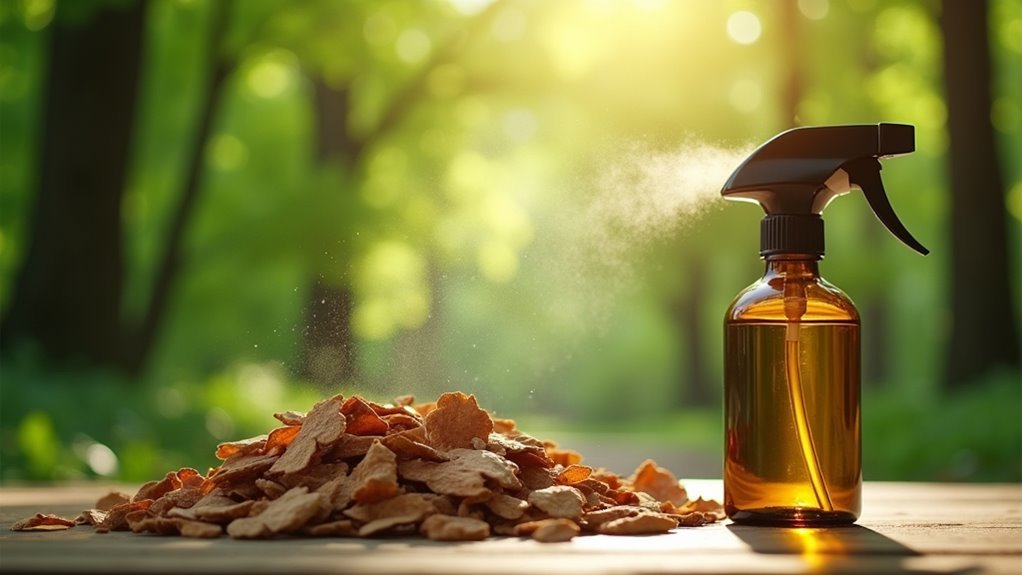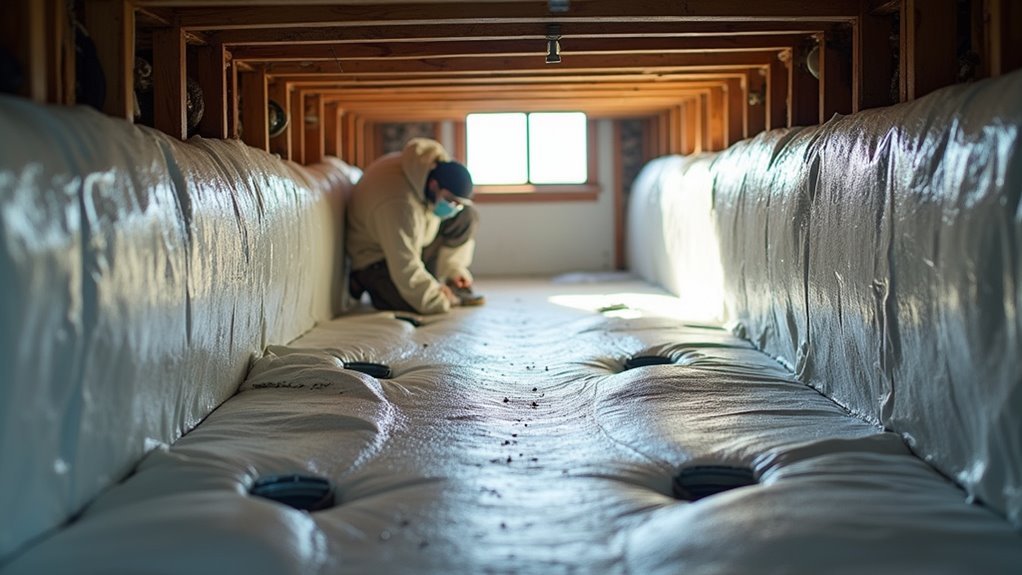Cedar oil effectively repels fleas through multiple attack mechanisms that overwhelm their survival systems. When you apply cedar oil, its volatile compounds disrupt flea breathing mechanisms, causing respiratory distress while simultaneously triggering fatal dehydration through neurotoxic effects. You’ll find it overwhelms their sensory systems, leading to disorientation and blocking communication pathways essential for reproduction. The oil’s strong scent prevents fleas from locating food sources, and it targets adults, eggs, and larvae through rapid moisture stripping upon contact, matching chemical insecticide potency at proper concentrations.
How Cedar Oil Disrupts Flea Nervous Systems

When cedar oil comes into contact with fleas, it launches a multi-pronged attack on their nervous systems that proves remarkably effective.
Cedarwood oil disrupts their breathing mechanisms, triggering immediate respiratory distress that leads to fatal dehydration. The neurotoxic effects overwhelm fleas’ sensory systems, causing severe disorientation and panic. This disruption blocks their ability to process environmental signals, effectively severing essential communication pathways they need for survival and reproduction.
The oil’s desiccant properties accelerate moisture loss throughout their bodies, creating a dual assault that combines neurological interference with physical deterioration.
Cedar oil’s dual-action formula strips vital moisture while simultaneously attacking flea neurology, ensuring complete elimination through combined physical and neurological breakdown.
You’ll find this natural compound can repel fleas as effectively as synthetic alternatives when applied correctly. The overwhelming scent alone serves as a powerful deterrent, while direct contact guarantees maximum nervous system disruption and rapid elimination.
The Science Behind Cedar Oil’s Dehydrating Properties
Beyond its neurological assault, cedar oil’s most devastating weapon against fleas lies in its powerful desiccant properties that systematically strip moisture from their bodies.
Cedarwood oil’s active compounds disrupt fleas’ natural ability to regulate water loss, causing rapid dehydration upon contact. This natural alternative proves remarkably effective – research shows it matches chemical insecticides’ potency at high concentrations.
The oil kills adult fleas while also targeting eggs and larvae through its dehydrating properties, though it doesn’t completely eliminate the flea life cycle.
The strong scent of cedarwood overwhelms their olfactory receptors, preventing food location and reproduction.
These essential oils offer superior pest control by combining multiple attack mechanisms, making cedar oil an invaluable weapon in your flea-fighting arsenal.
Cedar Oil Application Methods for Maximum Flea Control

The effectiveness of cedar oil against fleas depends entirely on how you apply it, and mastering the right application methods can mean the difference between occasional relief and complete pest elimination. Cedarwood oil requires strategic application across three key zones for thorough natural flea control.
| Application Zone | Method | Frequency |
|---|---|---|
| Indoor spaces | Mix diluted mixture in spray bottle, target carpets/furniture | Every few days |
| Pets | Apply directly to coat, avoid sensitive areas | Dogs: 1-3 days, Cats: weekly |
| Outdoor areas | Spray around grass/shrubs where fleas hide | Every 3 weeks |
You’ll need to reapply frequently since cedar oil evaporates quickly. Combining with other essential oils like peppermint creates a more effective repellent for maximum flea control.
Combining Cedar Oil With Other Natural Repellents
You’ll amplify cedar oil’s flea-fighting power by combining it with other natural essential oils that target different aspects of flea behavior and biology.
Strategic blending creates synergistic effects where oils like peppermint, neem, lavender, and lemongrass work together to overwhelm fleas’ sensory systems while disrupting their growth cycles.
These natural formulations deliver enhanced repellent effectiveness that’s often superior to using cedar oil alone.
Essential Oil Synergies
While cedar oil proves effective on its own, combining it with other essential oils creates powerful synergistic blends that enhance flea repellent properties.
You’ll discover that cedarwood oil pairs exceptionally well with peppermint oil, whose strong scent disrupts flea communication more effectively than single-oil treatments.
Adding neem oil introduces azadirachtin, which targets flea reproduction and growth cycles.
Lavender oil not only boosts flea-repellent properties but also provides calming benefits for your pets during pest control applications.
Lemongrass oil’s citronella content creates fresh-scented, natural and effective flea treatments.
You can use these combinations in an essential oil diffuser or create homemade sprays.
These diverse compounds work together, targeting multiple aspects of flea behavior and lifecycle stages for superior results.
Natural Blend Formulations
Creating effective natural blend formulations requires strategic combinations that maximize cedar oil’s flea-fighting potential through carefully selected companion ingredients.
When you combine cedarwood oil with essential oils like peppermint, neem, lavender, or lemongrass, you’re leveraging their synergistic properties and insect-repelling qualities for superior pest control.
These natural blend formulations create an all-encompassing approach that disrupts the entire flea life cycle, targeting adults, larvae, and eggs simultaneously through repelling and desiccation methods.
The combined aromatic intensity overwhelms fleas’ olfactory receptors, making treated areas highly unattractive to infestations.
You can apply these versatile blends as sprays, in diffusers, or on pet collars, ensuring targeted prevention strategies that effectively repel fleas while maintaining safe, chemical-free environments for your family and pets.
Enhanced Repellent Effectiveness
Since cedar oil’s natural flea-repelling properties can be greatly amplified through strategic combinations, you’ll achieve superior pest control by blending it with complementary essential oils that target different aspects of flea behavior and biology.
Cedarwood oil with peppermint oil creates enhanced effectiveness by disrupting flea communication through peppermint’s strong scent.
When you combine it with neem oil, you’ll target both adult fleas and larvae for thorough flea control.
Mixing cedarwood oil with lavender oil repels fleas while calming your pets simultaneously.
Adding lemongrass oil boosts efficacy through its high citronella content.
Research confirms that these essential oil combinations create a more lethal natural solution against fleas than using cedar oil alone.
Safety Considerations When Using Cedar Oil Around Pets
Although cedar oil offers an effective natural solution for flea control, you must prioritize your pet’s safety when incorporating this essential oil into your pest management routine.
When using cedar oil for flea control, always put your pet’s safety first before implementing any natural pest management strategy.
Cedarwood oil is safe for pets when you follow proper usage guidelines, including adequate dilution at 10-15 drops per ounce of carrier oil.
Always perform a patch test on your pet’s sensitive skin before full application to identify potential adverse reactions like redness or swelling.
Since cats show heightened sensitivity to essential oils, you’ll need lower concentrations and should consult with your veterinarian beforehand.
Monitor your pet closely for signs of irritation or discomfort, and prevent licking treated areas until complete absorption occurs.
Limitations and When Professional Treatment Is Necessary

While cedar oil provides valuable flea repellent properties, it comes with significant limitations that you should understand before relying on it as your primary pest control method. Cedar Oil Kill Fleas effectively, but it doesn’t target the entire flea life cycle, particularly larvae and eggs. This creates ongoing infestations despite treatment efforts.
| Cedar Oil Limitations | Professional Solutions |
|---|---|
| Targets adult fleas only | Addresses entire flea life cycle |
| Requires frequent reapplication | Long-lasting treatments |
| Insufficient for severe flea infestations | Handles large populations effectively |
| May cause pet sensitivities/adverse reactions | Safer, tested formulations |
| Limited thorough management | Complete pest control solutions |
For severe flea infestations or persistent problems, professional treatment becomes necessary to achieve complete eradication and prevent recurring issues.
Frequently Asked Questions
How Effective Is Cedar Oil Against Fleas?
Cedar oil’s highly effective against adult fleas, disrupting their nervous systems and causing death through suffocation. You’ll need frequent reapplication since it evaporates quickly, and it won’t eliminate eggs or larvae completely.
What Are the Disadvantages of Cedarwood Oil?
You’ll find cedarwood oil requires frequent reapplication, won’t eliminate severe infestations, and can’t target flea eggs or larvae effectively. Your pets might experience sensitivities, and you’ll need higher concentrations for meaningful results.
Which Essential Oil Repels Fleas the Most?
You’ll find cedarwood oil repels fleas most effectively among essential oils. Its strong scent overwhelms flea sensory receptors and disrupts communication, while its desiccant properties dehydrate fleas and their eggs completely.
Why Does Cedar Oil Kill Bugs?
Cedar oil kills bugs by disrupting their nervous systems and overwhelming their olfactory receptors. You’ll see it dehydrates insects through its desiccant properties, fundamentally suffocating them while breaking their reproductive cycles.
In Summary
You’ve learned that cedar oil’s multi-faceted approach makes it a powerful natural flea repellent. It’ll disrupt nervous systems, dehydrate these pests, and provide lasting protection when applied correctly. You can enhance its effectiveness by combining it with other natural solutions, but always prioritize your pet’s safety by following proper guidelines. While cedar oil won’t solve severe infestations, it’s an excellent preventative tool that’ll keep your home flea-free naturally.





Leave a Reply